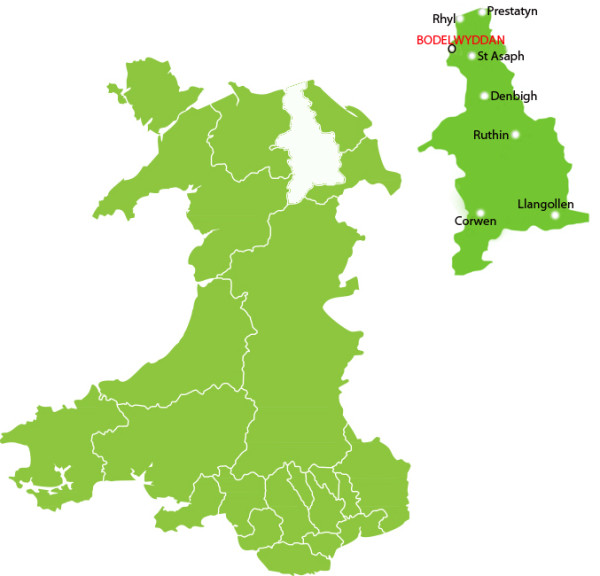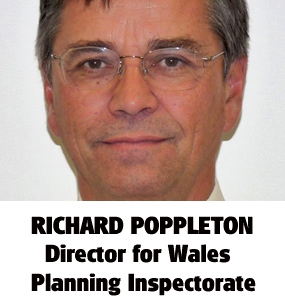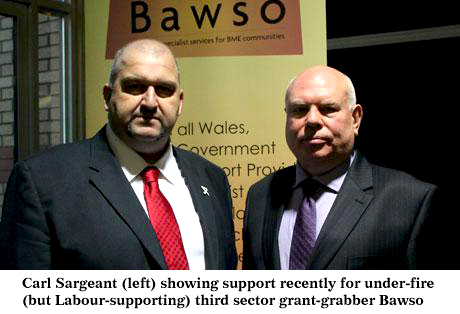I had intended putting this out on Twitter or Facebook, just to inform people that the deadline for representations on the planned 1,700 new homes at Bodelwyddan in Denbighshire has been extended to March 21st. In view of the new figures available for both population predictions and household size it is well worth challenged this plan because it is clearly no longer needed. (In fact, these 1,700 new homes were never needed.) I have chosen to develop the subject into a post after reading the planning inspectors’ report on Denbighshire’s Local Development Plan.

I want to pick out certain comments made by the inspectors because they are worthy of a wider audience. I say that because although we may be talking here of Bodelwyddan, or Denbighshire, the attitudes displayed by the inspectors have national implications. Because this is how they operate all over Wales.
Let’s start by identifying the inspectors, Anthony Thickett and Gwynedd Thomas. We can safely assume that the report is the work of Thickett and that Gwynedd Thomas is there to lend a little local colour. I Googled ‘Anthony Thickett’ and found his name linked to planning matters all over England and Cornwall in recent years. Though he seems to be based in Cardiff, which provides further proof that the Planning Inspectorate is an Englandandwales body, and answers to the Department for Communities and Local Government in London. So what did Mr Thickett have to say last year in response to Denbighshire County Council’s revision of their Local Development Plan? As you might imagine, I was specifically interested in those recommendations that related to housing.

Starting with 4.1 (page 16) we learn that, “The 2008 Welsh Government* projections indicate the need (my italics) for around 8,500 new units in Denbighshire between 2008 and 2023.” The council argued for a lower figure on the grounds that more recent statistics showed a reduced need. The inspectors would have none of it, and their response was a gem of officialese that can be found in the panel (click to enlarge). In essence, it says, ‘Yes, the council is quite right; but we shall still insist on thousands of unnecessary new housing units anyway’. So what are “the objectives and aspirations” that justify the Planning Inspectorate ignoring the council’s plea? We are told that Denbighshire has an ageing population – or “aging” according to the inspectors – with more deaths than births, which would result in a declining population unless young people moved in to the county. Let us examine this claim.
Denbighshire, like many other parts of Wales, has an ageing population due to the lack of a healthy and balanced economy. Worsened by tourism creating few worthwhile jobs for locals while attracting retirees and elderly people. This can be remedied, according to the inspectors, with a building programme to attract a younger population from outside of the county. But wait! if the lack of jobs forces many young people to move away, where are the jobs for this younger population moving in? Well, most of the jobs will remain where they are now, in Greater Manchester, Merseyside, Cheshire. For what the inspectors are really talking about is attracting a commuter population. (Apart from the riff-raff being dumped in the coastal ghettoes.) This explains why the bulk of the planned new housing is close to the A55. Moving on, what do Messrs Thickett and Thomas have to say on the Welsh language?

You may not have noticed – few have – that Cymdeithas yr Iaith Gymraeg (the Welsh Language Society) has started a campaign demanding that the Welsh language be a material consideration in planning matters. The inspectors address the very same issue, and produce another little gem of officialese (click panel to enlarge). What this says (again, in essence) is, ‘We shall always find a reason to ignore the Welsh language’. But there is sugar on the pill with the following assurance (yup, in essence), ‘Even though we are doing our best to kill off your language, and your very identity, we shall disguise this atrocity with Welsh street names in the new developments’. The kind of cheap and meaningless cosmeticism that has satisfied language (non-)campaigners in recent decades.
The answer to Denbighshire’s “aging” population is not an unending programme of house building but a healthy and balanced local economy to stabilise and grow the indigenous population. Coupled with a presumption against those housing developments designed to attract elderly buyers from outside Wales. These are hardly radical demands when Welsh identity is under threat in a way it never has been before. An assault that if it showed itself with the ugly visage of overt oppression would be resisted; but when it sidles up behind the mask of ‘development’ and ‘economic activity’, then too many are fooled. We cannot allow ourselves to be fooled any more. There are too many areas where we Welsh are already in a minority. It’s time to say, ‘Thus far and no further’. Speak out and don’t allow the colonisation of our homeland to be brushed under the carpet any longer.
Now is the time to do it. I say that because for years the Planning Inspectorate has had everything its own way, It has browbeaten our local authorities with questionable statistics produced by in-house statisticians demanding thousands upon thousands of new homes Wales doesn’t need. Demands then mouthed obediently for them by those traitorous buffoons down Cardiff docks. The game is up. No one can persist in arguing that Denbighshire needs 8,500 new homes to meet a population increase of 4,134, and a household size of 2.31, without admitting to a colonisation strategy.
Make a start by writing to Denbighshire County Council arguing against the plan for a new town of 1,700 homes next to Bodelwyddan. (Many councillors and council employees will be glad to hear from you.) Send an e-mail to planning@denbighshire.gov.uk or write to the Planning Department, Caledfryn, Smithfield Road, Denbigh LL16 3RJ. Why not also contact the Planning Inspectorate at their Welsh outpost: either e-mail wales@pins.gsi.gov.uk, or write to, The Planning Inspectorate, Crown Buildings, Cathays Park, Cardiff CF10 3NQ. Tell them you know what their game is, and from now on their ethnocidal strategy will be opposed.
* Talking here of “the Welsh Government projections” is rather naughty. The figures were produced by the Knowledge and Analytical Services which, like the Planning Inspectorate, has a few staff based in Cardiff, pretends it answers to the ‘Welsh’ Government, but is in reality part of the Department for Communities and Local Government in London.









